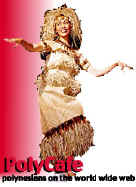





![]() French
Polynesia and Tahiti
French
Polynesia and Tahiti![]()
For more than 200 years, Tahiti has represented the tropical-paradise myth for Europeans, but ask almost anyone about French Polynesia and they will look at you blankly. Tahiti is, in fact, just one island in one of the five island groups that make up French Polynesia. It's the region's biggest, most famous and historically interesting island, but the glossy pictures of aqua-blue seas and palm-fringed beaches that you see in travel agents' windows are almost certainly some other French Polynesian island.
 People
come to French Polynesia to live it up in stylish resorts, scuba dive
in lagoons teeming with tropical fish, gorge on the unique mix of
French and Polynesian cuisine and, basically, experience a little
French chic mixed with South Pacific charm. And why not, since French
Polynesia is stunningly beautiful, but the enduring myth that it is
also an unproblematic tropical paradise was clearly exposed during the
riots that rocked Papeete's streets in September 1995, following the
resumption of French nuclear testing at Moruroa.
People
come to French Polynesia to live it up in stylish resorts, scuba dive
in lagoons teeming with tropical fish, gorge on the unique mix of
French and Polynesian cuisine and, basically, experience a little
French chic mixed with South Pacific charm. And why not, since French
Polynesia is stunningly beautiful, but the enduring myth that it is
also an unproblematic tropical paradise was clearly exposed during the
riots that rocked Papeete's streets in September 1995, following the
resumption of French nuclear testing at Moruroa.
Full
Name: French Polynesia
Area: 5 million sq km (2,000,000 sq mi). Land area: 3500 sq km
(1370 sq mi)
Population: 220,000 (Tahiti pop: 150,000)
Capital City: Papeete
People: 83% Polynesians (Maohis), 12% Europeans, 5% Asians
Languages: Tahitian, French and English
Religion: 55% Protestant, 30% Catholic, 6% Mormon, 2%
Seventh-Day Adventist, 2% Buddhist and Confucianist
Government: Overseas territory of the Republic of France
President: Gaston Flosse
GDP:
US$2.8 billion (1993)
GDP per head: US$12,750 (1993)
Major Industries: Tourism, pearling
Major Trading Partners: France, USA, Japan and New Zealand
